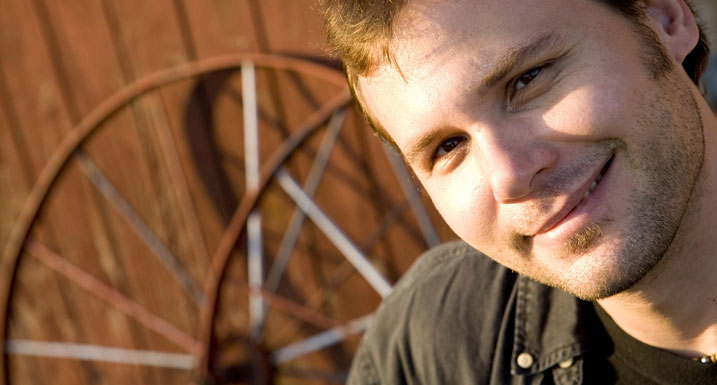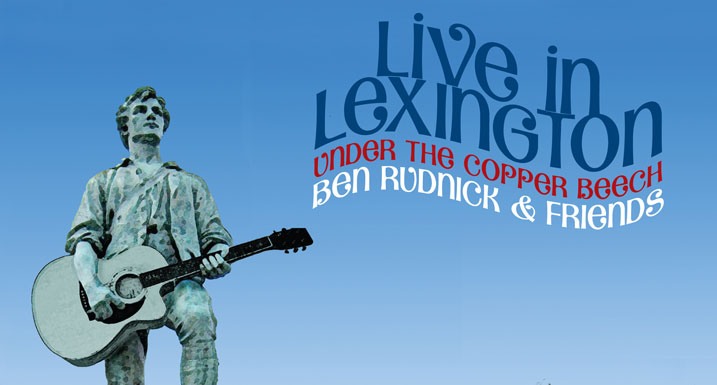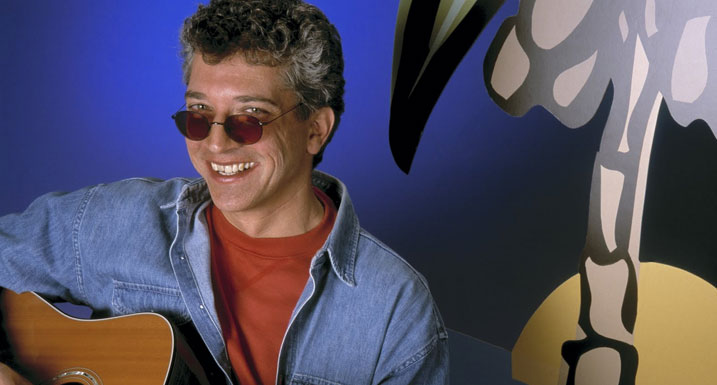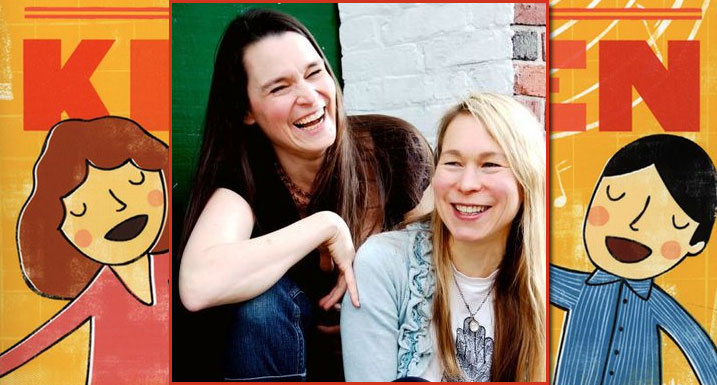
Photo: Mara Brod
This week heralds the return of Boston folk veteran Alastair Moock, whose debut kindie record, A Cow Says Moock, earned a slew of awards and rave reviews. Alastair’s follow-up, These Are My Friends, expands upon the promise of its predecessor, weaving a parade of special guests (including Rani Arbo, Kris Delmhorst, and Anand Nayak) through a collection of vibrant originals and judiciously chosen covers. As we discussed in the following interview, Alastair’s musical tradition includes everything from Sesame Street to Woody Guthrie and Ray Charles, and they’re all well represented here. No, seriously: These Are My Friends includes a Sesame Street favorite (“Ladybugs’ Picnic”), a page from the Guthrie songbook (“Mail Myself to You”), and a Ray Charles classic (“Yes Indeed”).
Sounds like a great combination, doesn’t it? It’s just the latest step in a career that has found Moock tilling rich musical traditions while remaining happily under the radar. Of course, if These Are My Friends turns him into a global kindie phenomenon, we don’t think Alastair will mind…
The last time I saw you was at the Meltdown a couple of years ago, and you were playing alone with an acoustic guitar in what was basically a hallway.
That’s right — that was just after the release of my first kids’ music album. I’ll be back there next year, but with a band this time.
I was just about to say, you’ve come a distance since then.
Yeah, that show was a last-minute thing. Bill Childs was kind enough to ask me to come out, and I was happy to do it, but…for sure, things have progressed for me in the kids’ music world. I’ve been making music for 15 or 20 years in the folk world, so I’m certainly not new to this, but family music was, in a lot of ways, like starting over. Not in musical terms — I think this stuff is part of the continuum of what I’ve always done — but the business is very different. The people who are running things are very different. The whole approach.
So on the business end, I have a booking agent now, and a publisher, and I feel like I understand this world much better this time around. I really enjoy it. I mean, the folk world is pretty genteel, all things considered [chuckles], but I think the people in kids’ music are even friendlier. Most of them seem to be in it for the right reason. I’m sure there are cutthroat elements out there, but especially in this indie circle I’m in, it’s a fairly small community. It’s really nice. It lets you feel like you can get your head around releasing an album.
On the new album, you used that “continuum” approach you described, partly through inviting guests who aren’t necessarily known for making family music, like Mark Erelli and Lori McKenna.
Yeah, and I was really excited to do that. I don’t know what it is about me, but community has always been kind of at the forefront to me. And I also really love taking on sort of the impresario role — of putting musicians in new places or combinations. It makes me excited that there are so many musicians that the audience maybe isn’t familiar with on the record. Where I am, the Boston area, it’s just choked with amazing talent everywhere I go. So I love that idea, and I also love making music with my friends, which is what this album was all about.
You mentioned the impresario approach, which is something I wanted to talk to you about. You put together the Pastures of Plenty concert series, which does exactly what you described in terms of bringing artists together in new combinations and contexts, which makes you sort of the Levon Helm of the Boston area.
[Chuckles] Well, yes. But there’s more than one of us. There are so many great musicians around here, and most of us don’t get a chance to hang out, because we’re usually playing at the same time. So anytime someone steps up and does something that can draw us all in, it’s exciting for everyone. But yeah, I started doing Pastures about 10 years ago — a little more now. It’s still going.
Let’s talk about the writing process for the new album. Do you have an overall approach to songwriting? Do you get up every day and punch in, or do you wait for inspiration to strike?
I don’t punch in. I wish I did. My wife is a fiction writer, and she’s far more disciplined than I am. No, I’m a very lazy writer, and I feel like the incentive I usually need is just the accumulation of a few songs that make me feel like I have an album in mind. Then I start getting excited, and start trying to fill in holes. I always try and approach a collection of songs as a collection of songs, so for me, a good album is one that has a lot of different elements.
And that’s reflected in These Are My Friends. It’s a nicely eclectic album, and although it’s identifiably part of the folk tradition, and none of it’s exactly what you’d call “produced,” you do incorporate a lot of interesting textures, sounds, and tempos.
It’s a little arcane now, because most people don’t listen to full-length albums — or listen to albums at all; they just download songs. But one of the nice things about the kids’ music world is that these albums are often given as gifts, and kids like to hold something in their hands. And once they have it, they want to listen to it over and over.
Which is the flip side, and sort of the awesome responsibility of being a kindie musician: you’re making music that parents often have to listen to repeatedly, so it’s important to sequence it as painlessly as possible.
Exactly, and that’s part of why I try to incorporate different sounds. People’s ears can’t take too much of the same thing. Especially kids’ ears — they need some rest. You can’t just hit them over the head with the same speed. And as far as writing goes, I’ve found it very freeing to work in the family music world. I have two audience members in my house, and they’re very attentive, honest listeners; they either get it or they walk out of the room, and I know I have to go back to the drawing board.
But humor has always been an element of my writing, and as an adult performer, I often didn’t know what to do with that. Woody Guthrie and John Prine are two of my heroes, and they did it successfully, but it’s a balance that I struggled with. I always had more fun writing the silly songs, and it seems to be a better fit with what kids enjoy listening to.
The humor in the music you’re talking about — the songs of Woody Guthrie, John Prine, or similar artists like Randy Newman and Loudon Wainwright III — is often most successful when it’s leavened with human drama, and I think that’s something you do on These Are My Friends. You know, a song like “Three Like Me” is funny, but it’s also poignant. There’s humor in the ways a three-year-old gets themselves into trouble, but you also flip the perspective: “how come people always yell at me?”
Yeah, it’s tough. And it isn’t really a conscious thing. Ultimately, you take in a lot as a listener, and then you start to put stuff out, hopefully in your own unique way, but it’s still a learning process. I don’t find humor that doesn’t have some sort of twinge of poignancy to be as valuable.
Was there a moment this time around when you knew you had an album?
I wrote “These Are My Friends” pretty early along, and once that happened, it sort of clicked. You know, as a father, I often feel like I’m more of a journalist than a songwriter, and that song is a good example, because my kids do have a lot of “friends” lying around the house. You know, nothing is in its original state. Curious George has to be wearing a purple hat. For a long time, my kids went through a string phase where they tied everything together, and we ended up with knots of toys and stuffed animals in these intricate webs.
But I love that. Their imagination is so raw, and that’s what that song is about. And as soon as I wrote it, I knew I had something, and I knew I wanted to involve my own friends, and that got me thinking about who I could involve. Like the song “Feets Up,” that Rani Arbo sings on, I had already been thinking of as a duet. That was something new for me this time around — thinking of writing for other people’s voices.
You cover a fair amount of traditional material on your albums. What’s your perspective on that as a songwriter? Is it difficult to line your own songs up with standards?
Sometimes it’s daunting. But it’s also really important to me. Almost all my adult albums have covers on them — a lot of Guthrie, Prine, and Dylan — and I did it because of the feeling that maybe there were people out there who hadn’t had the opportunity to hear those songs. People need to know them. This is our history. And with the kids’ albums, that feeling is even stronger. I mean, this is part of our heritage, and it’s so rich — I just have this educational urge to share it.
I actually have an educational project that I take into schools — it’s for older kids, third grade and above — where we look at how songs affected different social movements. How it keeps being reinterpreted and changed. I love thinking about that, and sharing it, and I feel like an album would be incomplete if it didn’t have those songs on it.
Most people who grow up to be professional musicians were once kids who were bitten by the musical bug at an early age, and now you’re playing to audiences with a lot of young people in them. What’s your perspective on your role in imparting that excitement — that love of music?
The most important question to me is whether or not I can reach the kids out there that will discover that love. If I can set that spark off in kids, where they not only think music is really cool, but realize it’s something they can make themselves rather than just turning on the radio or an iPod…it makes me really happy that my kids love to make up songs. And I don’t think they’re that unusual — I think most people do that, and it’s something they just shut down at some point.
Everyone reaches that sort of self-conscious adolescent stage. And you hope they can come out the other side and realize they can make their own art, whether it’s at home for their family or out at open mic nights, or even trying to make a career out of it. Those are all beautiful things.
Before I started making kids’ music, I was out of touch with the whole scene, and I had been since I was a kid myself in the ’70s. So it was exciting, and gratifying, to find artists like Dan Zanes and Elizabeth Mitchell — people who were tapping into these roots we share, and expressing the ideals of someone like Pete Seeger. Like Pete said, you can be a musician yourself, you can be an activist yourself — there’s no line between the citizen and the professional. And my urge to share those traditions comes back to that — to the knowledge that there was a time when there wasn’t such a separation between making art and just being a regular person. It’s wonderful that there are so many artists out there showing that to kids. Not preaching it to them — showing them.


